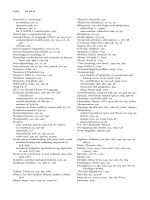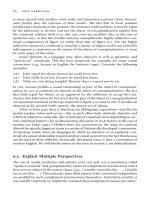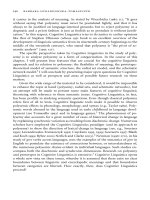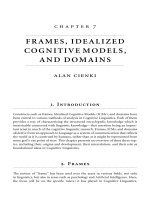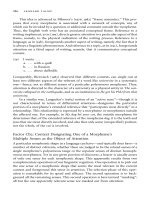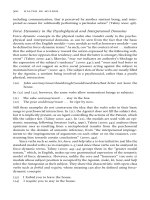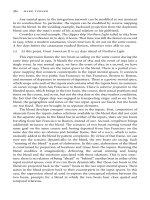The Oxford Handbook of Cognitive Linguistics Part 18 doc
Bạn đang xem bản rút gọn của tài liệu. Xem và tải ngay bản đầy đủ của tài liệu tại đây (160.9 KB, 10 trang )
it carries in the analysis of meaning. As stated by Wierzbicka (1985: 11), ‘‘It goes
without saying that polysemy must never be postulated lightly, and that it has
always to be justified on language-internal grounds; but to reject polysemy in a
dogmatic and a priori fashion is just as foolish as to postulate it without justifi-
cation.’’ In this respect, Cognitive Linguistics tries to do justice to earlier opinions
like that of Stephen Ullmann (whose 1951 book is an excellent overview of the
development of linguistic semantics from its nineteenth-century beginnings to the
middle of the twentieth century), who stated that polysemy is ‘‘the pivot of se-
mantic analysis’’ (1951: 117).
The specific perspective taken by Cognitive Linguistics in the study of poly-
semy is to analyze polysemy as a form of categorization. In the course of this
chapter, I will present four features that are crucial for the cognitive linguistic
approach and its relation to polysemy: the flexibility of meaning, the prototype-
theoretical model of semantic structure, the radial set model, and the schematic
network model.
2
I will conclude by presenting major open questions for Cognitive
Linguistics as well as prospects and areas of possible future research on these
matters.
Given the wide range of the material to be considered, it would be impossible
to exhaust the topic at hand (polysemy, radial sets, and schematic networks), but
an attempt will be made to present some main features of cognitive linguistic
theorizing with reference to these semantic issues. Cognitive Linguistics, in fact,
has been prolific in studying semantic questions. Even though classical polysemy
refers first of all to lexis, Cognitive linguistic tools make it possible to observe
polysemic effects in phonology, morphology, and syntax (e.g., Taylor 1989). Poly-
semic words abound in the language used in early childhood in language devel-
opment (see Tomasello 1992) and in language games.
3
The phenomenon of po-
lysemy also accounts for a great number of cases of historical change in language
by explaining synchronic variation as resulting from diachronic change. Numerous
scholars have employed the Cognitive Linguistics paradigm (and its approach to
polysemy) to show the direction of lexical change in language (see, e.g., Sweetser
1990; Lewandowska-Tomaszczyk 1992; Cuyckens 1995, 1999; Geeraerts 1997; Blank
and Koch 1999; Bybee 2000; Nerlich and Clarke 2003).
4
Newman (1996: 270), in his
study of give verbs across languages, uses the examples of the semantics of give in
English to postulate the existence of connections between, or interrelatedness of,
the numerous polysemic chains evident in individual languages. Such studies en-
compass both the diachronic and synchronic dimensions. Research on polysemy
and prototypes in Cognitive Linguistics is extensive.
5
Cognitive Linguistics opens
a whole new vista on these issues, whereby it is assumed that there exist no clear
boundaries between linguistic and encyclopedic meanings and that boundaries
between categories are blurred. How exactly, then, does Cognitive Linguistics
proceed?
140 barbara lewandowska-tomaszczyk
2. Polysemy Tests and
the Flexibility of Meaning
The descriptive models of polysemy that Cognitive Linguistics focuses on (proto-
typicality, radial sets, schematic networks) share a concern for the flexibility of
meaning. As a first step, we may have a look at existing polysemy tests and the
way they reveal the flexibility of meaning. A number of tests, thoroughly discussed
in Geeraerts (1993), Tuggy (1993), and Dunbar (2001) and conveniently summa-
rized in Ravin and Leacock (2000), have been proposed in the logical, philosoph-
ical, and linguistic literature to distinguish polysemy from vagueness. An exami-
nation of these tests shows that they do not necessarily detect the same meaning
phenomena: what has to be considered a different meaning is not a self-evident
matter.
2.1. The Logical Test
The diagnostic polysemy test proposed by Quine (1960) states that a word is
polysemic if an assertion involving that word can be both true and false of the same
referent. Quine’s test shows that vague meanings (i.e., meanings that are unmarked
for a certain category distinction) do not pass the logical test. If the word student
were polysemic between a reading ‘male student’ and ‘female student’, then it
would be possible, according to the test, to truthfully utter sentence (1); that is, for
any given student, only one of the readings would be applicable. The awkwardness
of (1) shows, however, that student is vague or unmarked rather than polysemic
with regard to the distinction between ‘male student’ and ‘female student’.
(1) I gave the book to a student but not to a student.
Analyzing the status of the form port, on the other hand, Geeraerts ( 1993: 229)
shows that it passes the test, so it is polysemic between the two readings ‘harbor’
and ‘certain type of fortified wine’:
(2) Sandeman is a port (in a bottle) but not a port (with ships).
As (2) shows, Quine’s test does not seem to discriminate between polysemy
and homonymy, given that the two readings of port are homonymous. A similar
example with the word light provided by Quine (1960: 129) also passes the poly-
semy test:
(3) The feather is light (not heavy) but not light (dark).
Quine (1960: 129) concludes that ‘‘an ambiguous term such as light may be at once
clearly true of various objects (such as dark feathers) and clearly false of them.’’ In this
case, the ambiguity involves readings that are etymologically unrelated; the two
readings are homonyms rather than polysemes. In fact, the distinction between
polysemy, prototypes, and radial categories 141
polysemy and hom onymy is traditionally made by invoking historical criteria. Iden-
tical forms with historically related meanings are polysemic items and are distin-
guished from those words, usually referred to as homonyms, whose forms happen to
be identical for historical reasons but whose meanings are etymologically unrelated.
In some cases, originally homonymic forms may be reanalyzed as being con-
ceptually related: a conceptual connection may be synchronically established be-
tween word meanings that are not historically related. Langacker (1987: 387) gives
the following example:
Sometimes, as with the central senses of tree, the similarities are cognitively sa-
lient and would likely be noticed even in the absence of common symbolization. In
other instances the resemblance is quite tenuous. Many speakers treat the mean-
ing of ear implied by ear of corn as an extension from the prototypical value of ear
as a body-part term; it is doubtful that the concepts would ever be compared were
it not for their identical symbolization. The cognitive distance and entrenchment
of such categorizing relationships are obviously variable. Homonymy represents
a limiting case, where the comparison of two identically symbolized concepts re-
veals no similarity that is salient or plausible enough to establish a categorization
achieving unit status. For a speaker who fails to notice any special resemblance
among the meanings of bill (proper name; request for payment; protrusion on a
bird, cap, or platypus), the semantic units do not unite to form a network and are
connected only via their common symbolic correspondent.
An analysis of the semantic reanalysis processes that take place in such cases may be
found in Geeraerts (1997: 130–50). Taylor (1989) and Blank (2003) present examples
of the converse case, when words that are historically related come to be perceived
as unrelated by contemporary users of the language. Taylor (1989) mentions En-
glish a pupil at school and the pupil of the eye; Blank (2003: 276) mentions French
voler ‘to fly’ and voler ‘to steal’ and German Schloss ‘lock’ and ‘castle’. What can be
observed here then is the diachronic flexibility of meaning, specifically regarding
the borderline between polysemy and homonymy: meanings that are historically
unrelated may come to be perceived as related, and, conversely, existing percep-
tions of semantic relatedness may wither.
2.2. The Linguistic Ambiguity Test
A second diagnostic test for polysemy was originally formulated by Zwicky and
Sadock (1975) and later rephrased by Cruse (1986). This test is of a linguistic nature.
One version of the test says that when polysemic words are used in one sentence, they
result in a zeugmatic combination, as in the example of the word expire:
(4) ?Arthur and his driving license expired last Thursday.
Discussing the word dissertation, Cruse showed that the incompatibility of readings
(which would establish polysemy) is heavily context-bound and is thus a question
of degree rather than an all-or-nothing matter:
142 barbara lewandowska-tomaszczyk
(5) ?Judy’s dissertation is thought provoking and yellowed with age.
(6) Judy’s dissertation is still thought provoking although yellowed with age.
According to (5), the material and the abstract reading of dissertation (referring
either to a book as a concrete volume or to a body of knowledge as an intellectual
achievement) appear to be polysemicly incompatible. The context presented in (6),
however, suggests that the two interpretations do not constitute different senses.
Another version of the linguistic test involves the use of the anaphoric so do
construction as in:
(7) I was busy dressing, and so were they.
The use of a polysemic item in the two clauses (e.g., dressing in the sense of putting
on a dress, etc., in the first clause, and dressing in the sense of, say, military troops
coming to the proper alignment, in the so do part) renders a zeugmatic combi-
nation. However, when the sense of dressing in both of the clauses is simply vague
between putting on different kinds of clothes, the sentence is acceptable.
2.3. The Definitional Test
Finally, there is the most classical, definitional test, whose origin can be traced back
to Aristotle’s Metaphysics. A word is considered polysemic if more than a single
definition is needed to account for its meaning. In semantic field theories and their
extensions involving feature matrices (Katz and Fodor 1963), this principle was
interpreted in terms of sets of necessary and sufficient conditions for category
membership. In other words, if no single set of necessary and sufficient conditions
suffices to account for the meaning of a word, the word is considered polysemic.
Basic criticism, referred to as Plato’s Problem by Laurence and Margolis (1999: 14),
which has been leveled against the Classical Theory of concepts, states that for most
concepts definitions are difficult to give.
We see, to conclude, that none of the three basic tests as such is without problems.
On top of the problems that issue from the contextual flexibility of meaning, we
may note that the three tests do not necessarily yield the same results. One of the
examples mentioned by Geeraerts (1993) involves autohyponymous words.
6
In such
words, a general sense includes a more specific one, such as egg ‘reproductive body
from various animals’, ‘egg from a bird, with a yellow yolk, surrounded by a hard
shell’, and so on (see Lehrer 2003: 229)ordog ‘member of the species Canis fa-
miliaris’ (general reading) and ‘male member of the species Canis familiaris’ (re-
stricted reading). The distinction between the two readings of dog can be estab-
lished by means of the logical test, given that a sentence like Mirza is a dog but not a
dog is fully acceptable when Mirza is female. The definitional test, however, cannot
establish a distinction between both readings, because the more restricted reference
polysemy, prototypes, and radial categories 143
is always included in the more encompassing definition. The fact that there is no
complete correspondence between polysemy tests, then, suggests that meaning is a
flexible phenomenon and that the boundaries between homonymy, polysemy, and
vagueness are not rigid.
3. Prototype Theory
The suggestion that categorial meaning is flexible receives an initial expression in
prototype theory. (The term ‘‘initial expression’’ is used here because we will see
later on that a further extension toward a schematic network model of semantic
structure is necessary.) The starting point of the prototypical conception of cate-
gorial structure is summarized in the following statement:
When describing categories analytically, most traditions of thought have treated
category membership as a digital, all-or-none phenomenon. That is, much
work in philosophy, psychology, linguistics, and anthropology assumes that ca-
tegories are logical bounded entities, membership in which is defined by an item’s
possession of a simple set of criterial features, in which all instances possessing
the criterial attributes have a full and equal degree of membership. In contrast, it
has recently been argued that some natural categories are analog and must
be represented logically in a manner which reflects their analog structure. (Rosch
and Mervis 1975: 573–74)
The traditional conception rejected in this statement is sometimes referred to
as the Classical Theory of concepts, which has had a long history in philosophy
dating back to antiquity (e.g., Aristotle 1984; Plato 1981; Locke [1697] 1960; Carnap
1978). Its main tenet is that concepts have definitional structure in the sense that
they encode necessary and sufficient conditions for their application.
7
For exam-
ple, the concept ‘bachelor’ can be interpreted in terms of the Classical Theory as a
complex mental representation that is composed of a set of features (semantic
markers) such as male, adult, and not married (see Katz and Fodor 1963). In this
section, I will discuss the way in which Cognitive Linguistics developed a prototype-
based conception of semantic structure that goes against the Classical Theory. Two
basic steps need to be taken: the identification of various prototype effects and the
development of a radial set model of semantic structure as a generic model un-
derlying the prototype effects—and which at the same time applies to polysemic
sets of meanings. The third part of this section presents a number of additional
issues concerning prototypicality and radial sets.
144 barbara lewandowska-tomaszczyk
3.1. Prototype Effects
In contrast with the so-called Classical Theory, features that are frequently men-
tioned as typical of a prototype-theoretical conception include the following (first
proposed by Geeraerts 1989):
a. Prototypical categories exhibit degrees of typicality; not every member is
equally representative for a category.
b. Prototypical categories are blurred at the edges.
c. Prototypical categories cannot be defined by means of a single set of cri-
terial (necessary and sufficient) attributes.
d. Prototypical categories exhibit a family resemblance structure, or more
generally, their semantic structure takes the form of a radial set of clustered
and overlapping readings.
Let us have a closer look at these four characteristics. Feature (a) involves the
recognition that category membership may be graded: some members of a category
are better, more typical members of the category than others. One of the first
contributions pointing to this was Berlin and Kay’s (1969) discovery of focal colors,
that is, the best examples of basic colors, which showed that these categories are not
uniform and contain central and peripheral members. Berlin and Kay’s studies were
found to match Eleanor Rosch’s experiments (Heider 1971, 1972), where she showed
that such central colors were psychologically real even for the speakers of the
languages which do not name such colors at all. They function as special cognitive
reference points and ‘‘best examples’’ or prototypes, more representative of the cat-
egory than other members. These asymmetries between the prototypical and pe-
ripheral category members were experimentally confirmed to be present in direct
goodness-of-examples rating, true-false reaction times, production of examples,
asymmetries in similarity ratings, and generalization. The discoveries concerning
graded category membership were first modeled by Zadeh (1965) in a form of set
theory known as fuzzy set theory, in which additional values between 0 and 1 are
allowed to capture category membership gradation.
When the attention is shifted from the center of a conceptual category to the
periphery, it appears that membership gradience may involve two different situa-
tions. Some categories like bird have rigid boundaries, in the sense that both
sparrows and penguins are clearly within the category boundaries, even though the
former are better exemplars of the category than the latter. Some other categories,
on the other hand, such as colors or old person, do not have rigid boundaries and
the graded category membership correlates with uncertainty concerning the bor-
derline of the concept: where exactly does old age begin? This leads to characteristic
(b): in some cases, the boundaries of a concept may be vague.
Characteristics (a) and (b) both involve the members (exemplars or subclasses)
of a concept: some members are more typical than others, and sometimes mem-
bership status may be unclear. Characteristic (c) looks at the definitional structure
of the category rather than the membership structure. It involves the absence of
polysemy, prototypes, and radial categories 145
classical definitions for a category: if no definition in terms of necessary and suf-
ficient attributes is available for a category, then that category is defined less rigidly
than the classical model of definitions predicts. Instead of a single description con-
sisting of individually necessary and jointly sufficient features, the definition takes
the form of a cluster of partial descriptions. Suggestions in this direction were first
formulated within philosophy by Wittgenstein (1953) and Quine (1953, 1960), then
in psychology by Rosch (1973), and others. Wittgenstein showed that a concept such
as ‘game’ could not be adequately defined according to the classical model. Instead,
the members of such categories are related by what he called family resemblance.
Family resemblance involves a polythetic,orsimilarity classification, where members
of a class share some of the characteristics, none of which, however, is sufficient for
class membership. Such cases contrast with what is called in science monothetic
classes, characterized by sets of discrete, singly necessary and jointly sufficient cri-
teria. Polythetic classification may be schematically represented as a pattern, where,
for instance, three categories A, B, and C display different but overlapping sets of
properties: A: p, q, r; B: r, s, t; C: t, u, v (see Needham 1972). Members of class A share
one property with class B, which shares one property with class C, even though class
A and C have no common characteristics. No common core can thus be identified
for all category members (see, e.g., Fodor 1981 for the analysis of paint and Fillmore
1982 for the discussion of climb). Another line of criticism concerning the Classical
Theory (after Laurence and Margolis 1999) is associated with the problem of an-
alyticity and analytic inferences it was to account for. In his critique of analyticity in
‘‘Two Dogmas of Empiricism,’’ Quine (1953) successfully argued that there is no
tenable analytic-synthetic distinction that would underlie the Classical Theory.
It will be clear that characteristics (c) and (d) are mutually related: it is precisely
the absence of a classical definition as signaled by (c) that leads to a definition in
terms of family resemblances, as indicated by (d). If we cannot find a set of features
shared by all birds that is sufficient to distinguish birds from non-birds, then our
definition of ‘bird’ will have to take the form of a cluster of overlapping sets of
features that each describe classes of birds. In contrast with the example just given,
however, there might well be a set of common features (like the fact that all birds are
born from eggs), but the set of common features is not sufficient to distinguish
birds from other specifies (likereptiles,asfar as the reproductive system is involved).
Such common features, even though they are jointly not distinctive enough for the
category as a whole, will carry more structural weight in the definition of ‘bird’ than
the features that are shared by only a subset of birds. And even among the features
that are not common to all birds, some will be more frequent than others: not all
birds have wings (think of the kiwi) and not all birds can fly (think of the ostrich
and the chicken), but still, having wings or being able to fly are salient features of the
category bird. We see, in other words, that the elements of a family resemblance
definition need not carry equal weight: some features or clusters of features may be
more important for the description of the category than others.
146 barbara lewandowska-tomaszczyk
3.2. Radial Sets and Polysemy: The Extended
Version of Prototype Theory
Characteristic (d) is applied even more broadly in the context of Cognitive Lin-
guistics. Note, as argued in Geeraerts (1987), that the so-called absence of classical
definitions as such does not suffice to establish the nonorthodox, prototype-based
nature of lexical categories. Even in the classical model, the absence of a single
definition in terms of necessary and sufficient attributes is a regular feature of
lexical categories; in fact, in those cases where they are polysemic, if a polysemic
category is conceived of as one that cannot be adequately described by means of a
single definition, then it necessarily fits the description of (c) mentioned above.
This means that characteristic (c) is only a nontraditional feature of lexical meaning
when it applies to each of the polysemic readings of a lexical item. For the polysemic
lexical item as a whole, characteristic (c) simply coincides with the definitional test
of polysemy that was introduced earlier.
But then what about characteristic (d) when we look at a polysemic lexical item
as a whole, and not at each of the polysemic readings separately? One of the most
fruitful insights of Cognitive Linguistics is the recognition that the definitional
structure of a polysemic lexical item is similar to the definitional structure of a
single meaning. When we look at the relationship between different meanings of
a lexical item, we are likely to encounter the same phenomena that are typical of
single meanings. For one thing, there may be demarcation problems: it may not
be easy to draw a sharp line between one meaning and the other. (This is in line,
of course, with what we said earlier about the relationship between the different
polysemy tests.) For another, one meaning may carry more structural weight than
others, in the sense that it directly or indirectly lies at the basis of other meanings.
Observe, for instance, that bird might be used metaphorically to indicate an airplane
(as in A gigantic silver bird approached from the west). That metaphorical extension
from the ‘biological species’ reading would certainly be less salient than the latter
as such. This is true from a logical point of view (to the extent that the metaphorical
reading is a semantic extension of the former), from a psychological point of view
(to the extent that the metaphorical reading is less likely to be permanently stored
in the mental lexicon of the language user), and from a statistical point of view (to
the extent that the metaphorical reading is less common than the literal one).
The recognition that the same structural characteristics that apply to single
meanings also apply to polysemic sets of meanings is the basis for the radial set
model of conceptual structure. According to Kleiber (1990), the shift from single
meanings to polysemic clusters of meanings introduces the second stage of the
development of prototype theory. The first stage, dubbed the standard version of
prototype theory by Kleiber, involves members of one category and thus represents
an intracategorial perspective. The second stage (an extended version, in Kleiber’s
parlance) represents cases of intercategorial polysemy and involves members of more
than one category.
polysemy, prototypes, and radial categories 147
Brugman and Lakoff (1988; see also Lakoff 1987) describe the radial set model in
the following terms. Polysemic words consist of a number of radially related cate-
gories even though each of the polysemic senses can itself display a complex pro-
totype structure. The central radial category member provides a cognitive model
that motivates the noncentral senses. The extended senses clustered around the
central category are related by a variety of possible links such as image schema
transformations, metaphor, metonymy, or by partial vis-a
`
-vis holistic profiling of
distinct segments of the whole sense.
Some subtypes of, for instance, the category mother are (predictable) exten-
sions of the central member of the category (e.g., biological mother or stepmother).
Some others, however, develop when the central category does not productively
generate a new subcategory, but rather when convention and culture condition the
development of an unpredictable category. Such new submembers are considered
members of radial models of categorization. Lakoff (1987: 83) gives an example of the
Trobriands radial extension of the concept ‘mother’ to cover cases where a bio-
logical mother gives her child to an older woman in the community to bring it up
or, as in traditional Japanese culture, to the mother’s sister. What Lakoff proposes is
that ‘‘the center, or prototype, of the category is predictable. And while the non-
central members are not predictable from the central member, they are ‘motivated’
by it, in the sense that they bear family resemblances to it’’ (65).
The main properties of radial structures have been characterized by Lakoff
(1987: 379) as follows:
a. A radially structured category possesses no single representation. Both
central and noncentral subcategories have their own representations,
and no properties of subcategories can be predicated from the central
subcategory. The noncentral categories can be treated as variants of a pro-
totypical (central) model with no one core in common. All subcatego-
ries can be seen as bearing family resemblance to one another.
b. The noncentral subcategories are motivated by the central member; they
are neither predictable nor arbitrary.
c. An experientialist theory of thought and reason employing all kinds of
cognitive models (i.e., propositional, metaphorical, metonymic, and
image-schematic) is needed to account for the types of links between the
central and noncentral category members.
The concept of radial categorization may have interesting theoretical implications
for the relationship between language and culture. The Triobrands’ mother, ex-
tended to include non-mothers in the European sense, can be considered a poly-
semic extension from the perspective of European culture. However, in the Tro-
briand culture, it could be treated as a full-fledged central category member. Radial
structures, as observed by Lakoff (1987), provide one of the strongest arguments
against the objectivist treatment of cognition and semantics. Radial categories do
not objectively exist in the outside reality. Instead, together with the existence of
polysemic chains, they provide evidence for a theory of cognitive models that are
148 barbara lewandowska-tomaszczyk
shaped in accordance with the speakers’ perspective and their construal of the scene
(see Langacker 1987, 1991). The cognitive models at work in radial categories, in
other words, may be culturally specific; they do not so much reflect how reality
is carved up objectively, but rather how the mind creates different realities. Such
cases as the English adoptive mother and surrogate mother and the Japanese classifier
hon constitute culture-bound category variants according to Lakoff. The variants,
however, are not arbitrary even though they are not predictable. They are motivated
and constrained by the central subcategory: a plausible explanation for the periph-
eral extensions can be provided a posteriori.
In addition to lexical concepts such as ‘anger’ (Lakoff and Kovecses 1987),
‘truth’, and ‘knowledge’, linguistic categories like ‘nouns’ and ‘verbs’ and linguistic
constructions like there is have been shown to possess a polysemic radial structure.
For instance, Janda (1990) discusses the radial structure of the category of gram-
matical case in Czech and shows the dynamic nature of the category with the cat-
egory members, which enter both stable and new dynamic alliances. In fact, as
Lakoff (1987: 463) notes, in a cognitively based grammar, all grammar ‘‘will be a
radial category of grammatical constructions, where each construction pairs a cog-
nitive model (which characterizes meaning) with corresponding aspects of lin-
guistic form.’’ He further proposes to account for the theory of grammatical con-
structions in terms of a general theory of symbolic models, which are understood
as ‘‘pairings of models of form with other cognitive models’’ (467). ‘‘Grammatical
constructions,’’ in Lakoff’s wording, ‘‘are organized via prototype theory, using ra-
dially structured constructional categories’’ (584).
3.3. Additional Features of Prototypicality
There are three more things to mention regarding prototypicality: we have to look
into the sources of prototypicality, we have to examine the relationship between the
Geeraerts’s (1989) characteristics (a)–(d), and we have to say something about the
application of prototype theory outside the lexical realm in which it was originally
developed.
To begin with, it is generally taken for granted that the different prototype
effects enumerated in characteristics (a)–(d) may have different sources. Two major
explanations stand out.
First, prototype effects (and gradience in particular) may result from the fact that
concepts function as mental reference points. When we come across new phenom-
ena, we tend to interpret them in terms of existing categories (see Geeraerts 1997 for
an extended discussion in terms of efficiency and cognitive economy). These cate-
gories then function as Idealized Cognitive Models, as Lakoff (1987) calls them; they
are, so to speak, the yardstick by which we measure new objects and events. In the case
of gradience, then, different degrees of matching can be observed between an Idealized
Cognitive Model referring to a given object or event and the particular object and
polysemy, prototypes, and radial categories 149
